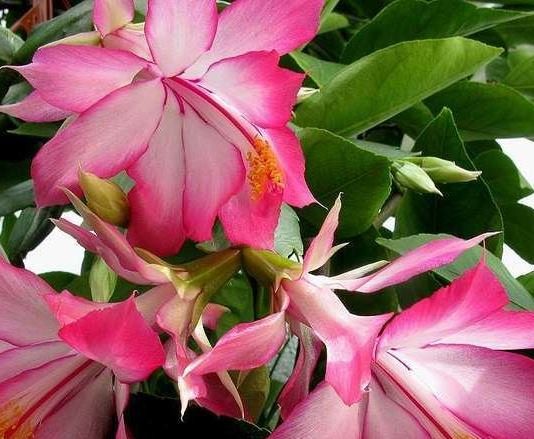Schlumbergera orssichiana
(Schlumbergera orssichiana)

Description
Schlumbergera opuntioides resembles other species of the genus Schlumbergera in that it has leafless green stems, made up of distinct segments, which act as photosynthetic organs. However, most other species have stems which are consistently strongly flattened, whereas in S. opuntioides, although young segments may be relatively flat, being 1.5–7.0 cm (0.6–2.8 in) long by 0.5–3.0 cm (0.2–1.2 in) wide, but only up to 9 mm (0.4 in) thick, the segments become more cylinder-shaped as they age, as well as becoming more woody. The plant may form a shrub up to 1.2 m (4 ft) tall. Special structures characteristic of cacti, called "areoles", occur in a roughly spiral fashion on the segments; most young segments have many areoles but a few have only a small number. The areoles, which normally have bristles which become stiffer with age, are where the flower buds appear. The flowers are held so that they are more or less horizontal; the upper side is different from the lower side (bilaterally symmetrical or zygomorphic). They are pink to purple in colour and about 6 cm (2.4 in) long with a diameter of 4.5 cm (1.8 in). The inner petals are fused at the base to form a "floral tube", which is white. In cultivation in the Northern Hemisphere, plants flower in the spring – March to April. The fruit is green, more or less spherical with four to five ribs. The brown to black seeds are about 1.75 mm (0.07 in) long. Schlumbergera opuntioides occurs only in the coastal mountains of south-east Brazil, in the states of São Paulo, Rio de Janeiro, and Minas Gerais, in the southernmost part of the tropics. Sites where it has been found include Mount Itatiaia in the Itatiaia National Park, the Serra da Mantiqueira in São Paulo, and the Serra do Ibitipoca in southern Minas Gerais. Plants are said to grow at altitudes of around 1,700 metres (5,600 ft) and 2,400 metres (7,900 ft). Because of their altitude and proximity to the Atlantic Ocean, the coastal mountains have high humidity – warm moist air is forced upwards into higher, colder locations where it condenses. S. opuntioides grows on trees (epiphytic) or on rocks (epilithic). It is listed in the category of "near threatened" due to loss of habitat in the IUCN Red List of Threatened Species. The specific epithet opuntioides means "like Opuntia", referring to the appearance of the stems.
Taxonomic tree:







